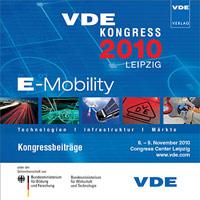Conceptional Considerations for Electrification of Public City Buses - Energy Storage System and Charging Stations
Conference: VDE-Kongress 2010 - E-Mobility: Technologien - Infrastruktur - Märkte
11/08/2010 - 11/09/2010 at Leipzig, Deutschland
Proceedings: VDE-Kongress 2010
Pages: 6Language: englishTyp: PDF
Personal VDE Members are entitled to a 10% discount on this title
Authors:
Sinhuber, Philipp; Rohlfs, Werner; Sauer, Dirk Uwe (Electrochemical Energy Conversion and Storage Systems, Institute for Power Electronics and Electrical Drives, RWTH Aachen University, Jaegerstrasse 17/19, 52066 Aachen, Germany)
Abstract:
Electrification of drive trains offers the chance for locally emission-free and quieter driving. The local public transport particularly needs to realize these two features. With the upcoming electrification of the individual transport by electric mobility concepts, its "green image" is at risk. Catenaries won’t be the solution due to high maintenance efforts and costs, the wish to preserve cityscape and missing flexibility of driving lanes. The introduction of battery powered buses is unavoidable and has started at several places in the world. Due to the high number of operation hours and the weight of the batteries, one battery charge won’t be sufficient to cover one entire day’s energy demand. Charging during operation offers the chance for unlimited driving range. Two concepts are considered: recharging at certain bus stops or exchanging (parts of) the battery pack with a fully charged one. The overall system configuration is a challenge, including possible battery recharge and exchange concepts, choice of battery technology, battery sizing, positioning and dimensioning of charging and exchange stations, the respective bus line’s characteristics and topography and many more. However, studies have shown that the local public transport in particular offers the chance to introduce battery powered vehicles. Load profiles for the bus and the battery are well known, allowing for a system design that optimizes battery use profiles and thus, cost effectiveness. Within this paper, considerations for sizing the battery system and for the energizing regime are given and discussed. The city of Aachen has been taken as an example and respective bus lines have been analyzed. Energy demand, travel distance and stop times have been evaluated. The hourly electric energy consumption of a vehicle can exceed 60 kWh. Assuming an appropriate ratio of charging time to operation time, charging at certain bus stops only would result in very high infrastructure costs. An energizing concept for a representative scenario is shown.


